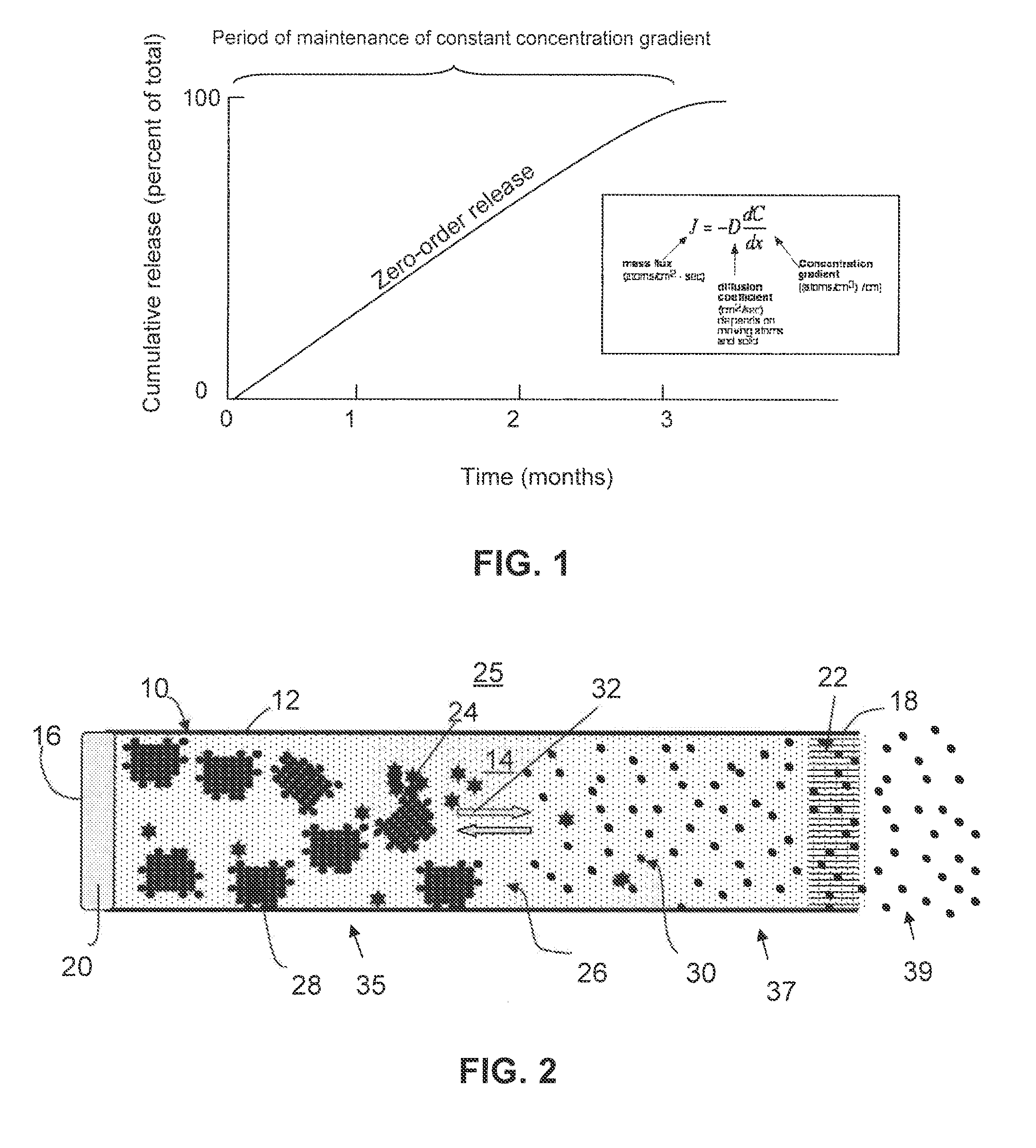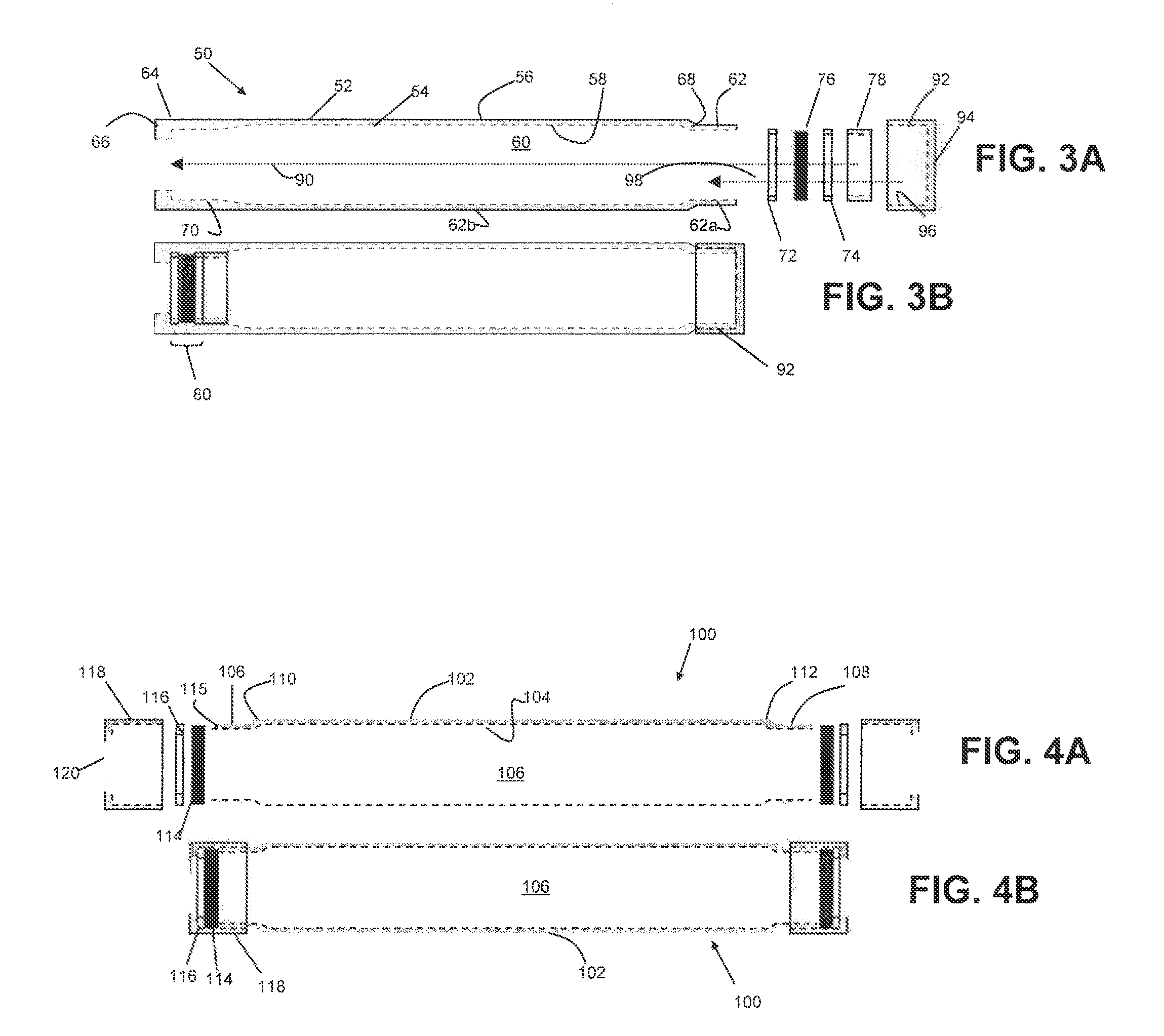Implantable device for long-term delivery of drugs
a technology of implantable devices and drugs, applied in the field of implantable drug delivery devices, can solve the problems of device rupture, shortening the service life of the device, and unable to meet the needs of extended delivery of low-water-soluble drugs, so as to increase the molecular weight, increase the effect of drug diffusion rate and constant drug diffusion ra
- Summary
- Abstract
- Description
- Claims
- Application Information
AI Technical Summary
Benefits of technology
Problems solved by technology
Method used
Image
Examples
example 1
In Vitro Release of Risperidone
[0101]Typical Franz-type diffusion cells were fitted with porous partitions separating a donor chamber from a receptor chamber. The porous partitions were membranes with pore sizes of 3,000 Daltons molecular weight cut-off, 100,000 Daltons molecular weight cut-off and a 0.45 micron polyvinyldenefluoride membrane filter (Durapore®). An aqueous suspension comprising risperidone (10 mg / mL PBS, pH 7.4) and poly(lactic-co-glycolic acid) was prepared and placed in the donor chamber of each cell. The cells were maintained at room temperature. Risperidone concentration in the buffer in the receptor chamber was measured by UV spectroscopy at 270 nm using an extinction coefficient for risperidone of 20.5. Buffer was diluted to 20-50 micrograms / mL prior to measurement to insure that the concentration was within the linear range of the UV measurement. Buffer was replaced each day. Results are shown in FIGS. 7A-7B.
example 2
In Vitro Release of Risperidone
[0102]Franz diffusion cells were prepared as noted above. Aqueous suspensions comprising risperidone (10 mg) and 5 mg, 10 mg, or 15 mg of 85:15 poly(lactic-co-glycolic acid) were prepared and placed in the donor chamber of each cell. The cells were maintained at room temperature. Risperidone concentration in the buffer in the receptor chamber was measured by UV spectroscopy at 270 nm using an extinction coefficient for risperidone of 20.5. Buffer was diluted to 20-50 micrograms / mL prior to measurement to insure that the concentration was within the linear range of the UV measurement. Buffer was replaced each day. Results are shown in FIG. 8.
example 3
In Vitro Release of Risperidone
[0103]Two groups of drug delivery devices were assembled as follows. Cylindrical titanium tubes, 4 mm in diameter and 35 mm in length, were prepared. Risperidone free base in the form of a dry powder (100 mg, Ren-Pharm Intl, particle size 2-100 micrometers) was filled into the a first group of devices (Group A, n=9). In a second group of devices (Group B, n=5), the same amount of risperidone was mixed with 5 mg 50:50 PLGA and with 15 mg 85:15 PLGA (Lakeshore Biomaterials, Birmingham, Ala.). The reservoirs of the devices were filled with phosphate buffered saline (PBS) at pH 7.4 under reduced pressure. Each of the devices in Group B was fitted with two regenerated cellulose membranes (5000 Daltons molecular weight cut off) at each end of the cylindrical tube by sandwiching the membrane between an o-ring and titanium frit (5 micron pores), as illustrated in FIGS. 5A-5B. The devices in Group A were identical, except the cellulose membrane was omitted, as ...
PUM
| Property | Measurement | Unit |
|---|---|---|
| depth | aaaaa | aaaaa |
| length | aaaaa | aaaaa |
| volume | aaaaa | aaaaa |
Abstract
Description
Claims
Application Information
 Login to View More
Login to View More - R&D
- Intellectual Property
- Life Sciences
- Materials
- Tech Scout
- Unparalleled Data Quality
- Higher Quality Content
- 60% Fewer Hallucinations
Browse by: Latest US Patents, China's latest patents, Technical Efficacy Thesaurus, Application Domain, Technology Topic, Popular Technical Reports.
© 2025 PatSnap. All rights reserved.Legal|Privacy policy|Modern Slavery Act Transparency Statement|Sitemap|About US| Contact US: help@patsnap.com



